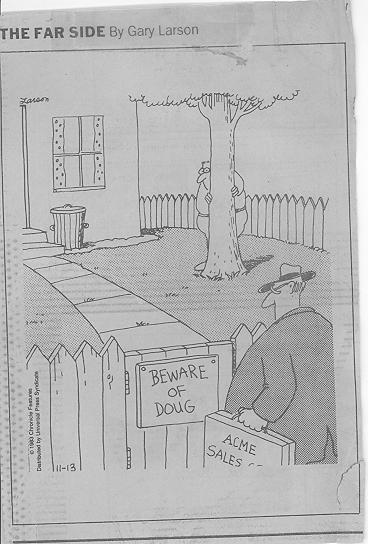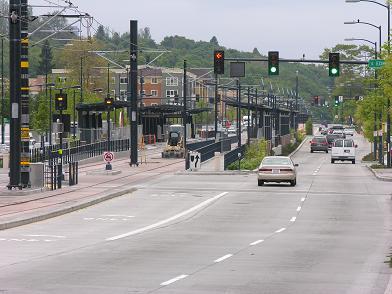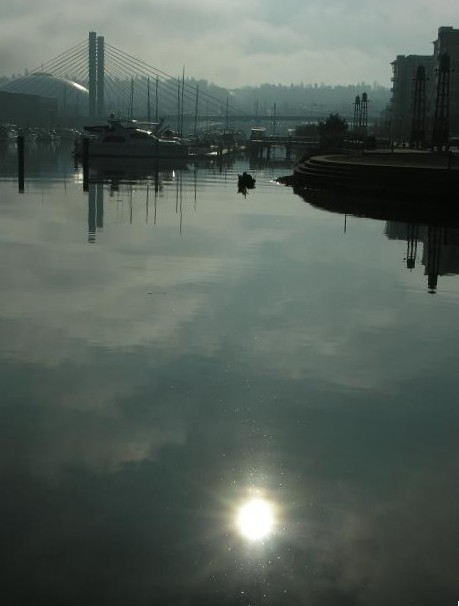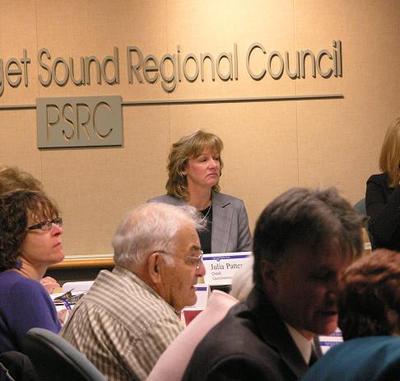The below piece was originally submitted for publication outside of Tacoma, but not accepted. As of today, January 19 it is slightly dated - for instance the refered alcohol impact area has unanimously passed the Tacoma City Council and has been sent to the State for action. This effort is profiled in a lead story in the TNT, January 18th.
************
Tacoma, in recent history, has had the reputation of being a second class City – growing slowly in the dark shadow of its more prosperous, and influential, neighbor to the North, Seattle. And this was not totally without justification. Tacoma’s Ruston Smelter spewed a plume of arsenic for decades creating a superfund site where the cleanup is just now finishing. The old joke about Tacoma was ‘Kiss me where it smells, take me to Tacoma” – due the once common NW odor of a pulp mill, the source being the Simpson Mill located on the now revitalizing historic Foss Waterway.
Part of that bad ‘reputation’ was in part through negative attitudes towards servicemen in the Vietnam era, locally articulated against members of the nearby Fort Lewis ‘community’. Those attitudes, and the resulting standards and procedures, are changing. Hopefully as Iraq combatants return they will find a City that welcomes their energy and drive. Tacoma will still have a large ‘transient’ military population, but that is not so bad as it might appear in High School statistics and the like. Having an Iraqi veteran as your next door neighbor could be a very good thing.
The revitalization of Downtown Tacoma has been incredible, and if you have not visited in the last few years you are truly missing one of the cultural hot spots of the State. Tacoma native Dale Chihuly gave a major gift to his hometown in building his Glass Museum, also overlooking the Foss. This same area is host to a more general arts museum, the State History Museum, and the University of Washington Branch campus, as well as a new convention center and a not bad Chihuly display in the renovated Union Station, now serving duty as our Federal Courthouse.
Downtown developers have been focusing on creating an urban alternative to Downtown Seattle – most of the Condos in downtown are not for the first time buyer – but just about every second home purchaser could afford them. The stock of historic buildings in Tacoma may well be greater than in Seattle proper – and the new projects being built are well designed to fit the history.
This revitalization has had considerable State and Federal money, no doubt in part due the seniority and moderate politics of Norm Dicks. The important fact about this public money is it appears to be working – unlike the failed urban revitalization programs of the 1970s money here has been spent smartly – first on the list being the UW Tacoma Branch, but also on the Tacoma Narrows Bridge and a major rebuild of I-5 through downtown, now about 50% complete.
With some controversy money has also been ‘given’ to the private sector in the form of tax breaks for development in strategic areas. Some might attribute this as ‘corporate welfare’ when they benefit the already well off. Time will tell if Tacoma’s efforts were a wise investment, or not. But so far, so good.
The Hilltop neighborhood once ruled by gangs has been the beneficiary of much of the public money. This area is still at risk, but it has changed considerably and living on its fringes is a very good bet. Most significantly the Sixth Avenue Corridor – stretching from Wright Park at the North end of Hilltop west towards the Narrows Bridge has revitalized itself incredibly in just the last year, and mostly with private money. It’s geographical position just to the south of the Proctor District and other historically affluent North End neighborhoods has perhaps made it the neighborhood of choice.
There are a lot of bars on Sixth – giving it a bit of a Ballard feel from the 1980s, but as a district located near the Tacoma Community College and University of Puget Sound, as well as being within easy Commuting distance of UW-T it works well as what it is.
At the other end of Downtown, towards the historically poor and transient military neighborhoods of South and East Tacoma the first rumblings of this economic momentum are being felt. This is my neighborhood, of the last four years. This article is my attempt to convey what I see is happening, as well as to assist in the area realizing its potential.
South Tacoma is perhaps the best deal in housing in Western Washington right now. For 200k you can buy a house comparable to a Wallingford bungalow. This is a price point that entry level home buyers can afford, even in today’s market. Sure, the plumbing or the electrical might need some work and the finish carpentry could stand some paint – but that’s part of being a first time homeowner – part of life.
The commute back north is doable, but rush hour starts early and ends late on all northbound commutes in Pierce County, as well as South King. The Sounder train though has made that commute enjoyable, if you are so lucky to work in an area it accesses.
The current southern terminus for the Sounder is at a funky little development called Freighthouse Square – comparable to Crossroads in Bellevue, or perhaps the old Fifth Street Public Market in Eugene. It is a ‘3rd place’ not a mall, built in the old rail freight depot for Tacoma. It’s in the Dome District, (we didn’t tear ours down), just at the Southern end of the Foss Waterway. It’s a funky mixture of old industrial and new retail and commercial now just coming into its own . It’s future seems to be comparable to that of the Pearl District in Portland, much like what has been attempted in the SODO area of Seattle, that somehow has never quite been realized, for some reason.
The Dome District has also seen quite a bit of public money lately, mostly transit related. Freighthouse Square is the Sounder station, and across the street is a (6 story) park and ride serving a local and regional bus hub. The Tacoma Light Rail, currently the only functioning element of Sound Transit’s Link project, starts between these two buildings, running north through Downtown to near 6th Avenue in the Theatre District.
The Sounder is planned to continue south to Lakewood – but the crossing of Pacific Avenue has become a major design issue. The small and medium sized businesses of the Dome District felt overlooked, if not bullied, by Sound Transit in this issue, the first ‘appearance’ of that ‘organization’ since their November Prop. 1 defeat. The question seems to have been resolved with the leadership of the Tacoma City Council. The ‘solution’ though has required the relocation of Tacoma’s oldest business, the Star Ice Company.
The first Tacoma residents I met were actually Sound Transit officials – perhaps most notably former City Councilmember Paul Miller and current State Commissioner of Public Lands Doug Southerland. Pacific Avenue, Highway 7, was however my first exposure to Tacoma. Looking at a map highway 7 looks to be the best way to get to the southern entrance and the Paradise area. One however is quickly disillusioned –seeking the solace of green one only finds hundreds of blocks of stop lights and commercial development of varying levels of upkeep – comparable to Hwy 99 north or south of Seattle.
Pacific Avenue as it leaves Downtown Tacoma is no exception. The road is slow and most of the businesses aren’t driver oriented. Currently the best route from the Dome District, and Downtown, is via McKinley Avenue, an I-5 overpass right next to the Tacoma Dome. McKinley Avenue climbs up McKinley Hill to its small neighborhood business district, itself just starting to revitalize, also home to Tacoma’s only dog park. Two dog park regulars have started that areas first coffeeshop, opening any day now. Although health regulations prohibit a dog friendly coffee hangout, the opening of this neighborhood coffeeshop is anticipated by many.
Just to the West , across Pacific, is my neighborhood, Lincoln, also home to the High School of the same name. The two neighborhoods make up what I’ve been calling ‘Presidents Ridge’ – a great area just above Downtown Tacoma with the potential to be a Ballard with a view, er, Admiral District. 34th Avenue is the small arterial connecting these areas and it makes a great view walk of about a mile or so, one way. There are two historic bridges over beautiful ravines in this area. The head of one of these has just been sold by the City of Tacoma to a Downtown Developer, Prium.
This Pacific Prium project has many in the neighborhoods of the South End concerned. Although District City Councilman Rick Talbert claims the housing to be developed will be for ‘firefighters and teachers’ the enabling council resolution which authorized the sale agreement is written to specifically suggest it is replacement housing for the very low income residents of the downtown’s Winthrop hotel. Somebody is lying to someone here, and I feel a bit guilty hoping that it is the housing activists, and not the neighborhoods.
The impact of 100-200 units of affordable housing raises the spectre of the blighted housing project, whatever the subsidized income level. Our neighborhood fears that this may mean downtown is looking at the South End not for revitalization, but as a ‘redlined’ neighborhood to milk as a low-income cash cow. Lincoln High School currently is gang free and we’d like to keep it that way – understanding that the risks of breeding gangs in newer style housing developments is less, it has also not been completely eliminated. The wisdom of placing younger children across the street from the County drunk tank and the methadone clinic also seems a bit unwise.
Most likely the answer will be determined by market forces – Prium is a local developer of high standing but they are having their own housing related financial problems right now – converting one condo project to rentals after failing to sell a single unit at their targeted price. Market savvy folks are betting that the results will depend on how much of a bailout Prium needs – not a bad financial hedge for a good company, all else being kosher.
Personally, I’m hoping for a mix of private and subsidized housing. Seattle is currently discussing the provision of density subsidies in exchange for the inclusion of affordable units – a good strategy. Central to this debate is the question of just how much of a mix can work. Though not directly applicable the desired mix in a privately funded project should also apply to a publically funded one. The maximum any city is doing in this generation of project is 35% - total, moderate income and for the very low.
Perhaps more potential is brewing in the next ravine to the east in that Dome Greenbelt. This is the route by which Hwy 705 climbs to reach Hwy 7 when you are heading South. It is also the alignment for a rail corridor owned by Tacoma Rail which stretches all the way to Elbe via Eatonville.
Just two weeks ago an Interior Department funded multi-jurisdictional study (Norm Dicks is currently chair of the Interior Committee) was released regarding the use of this corridor for Rail/Trail purposes. Unlike King County’s Eastside rail line this multiple use is being seriously, and professionally, studied – NOT decided by dysfunctional partisan political considerations.
Personally I’ve found that idea to be very timely – as I’ve been talking up the idea of a trail as well – not for the rail corridor, but for the Dome Greenbelt – built just above the I-5 soundwall, like the one on Seattle’s Capitol Hill (the BEST place to watch Fourth of July Fireworks shows). We’ll see if the kismet works, I hope you don’t mind the personal plug.
This trail would stretch all the way from the existing trail in McKinley Park to the pedestrian bridge at 38th, near the Tacoma Mall. That western end is the Whitman neighborhood, named after the Walla Walla poet. The proposal is articulated graphically here.
Pat McGregor is the President of the Whitman neighbors, a teacher at Puyallup’s Leschi school. He is perhaps the South End’s most effective leader – largely responsible for the expansion of Downtown’s ‘Alcohol Impact Area’ , scheduled for January adoption. Removing fortified products from store shelves isn’t the cure for all of alcohol’s ills, but it does seem to have some effect – as in Pioneer Square and elsewhere.
Our area certainly has customers for fortified alcoholic drinks – our freeway greenspaces have become homes for the homeless – in one case a nearby encampment was probably well over 100 individuals. These ‘customers’, along with the stereotypical meth addict scravenger regularly use our alleys as travel routes. Thankfully public safety is one issue that everyone agrees on, and efforts in this regard are just starting to build the foundations of solid neighborhood organizations.
Tacoma is building itself a new reputation these days – lets hope it becomes a City where folks who work hard can get ahead – and where everyone can afford a downtown condo once the kids leave. There are risks that the parasites who feed off the poor will attempt to expand their presence here, but I am optimistic. All life is risk, and preserving the history of a City like Tacoma is, in my opinion, a good bet.
Tacoma was once the business center for the State. The history, as I understand was that Tacoma received the first rail line, Everett the second – they joined up in Seattle, which, perhaps due the benefits of competition, became the number one City.
The current word for Tacoma is ‘gritty’. Like the nation’s second City, Chicago, Tacoma is a city of people who work for a living, who earn it. The ridge of the south end may well become the geographical ‘broad shoulders’ of the City – after all a ‘good’ economy is one that benefits everyone, no?




